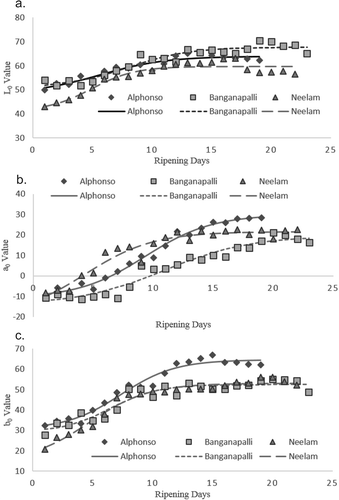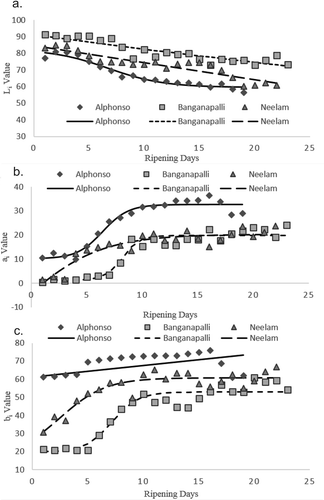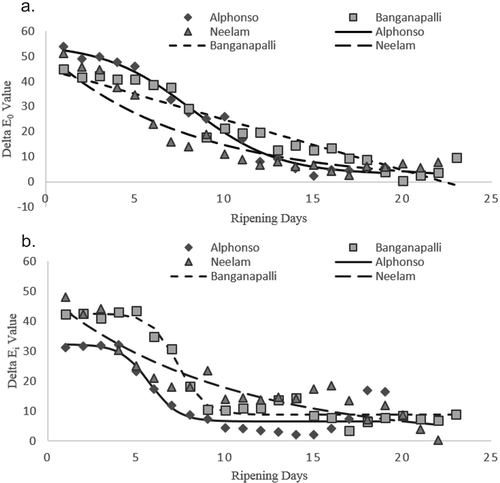Abstract
During ripening of mangoes, color change kinetics were studied with Alphonso, Banganapalli, and Neelam varieties. The internal and external color change was recorded using CIE-Lab color coordinates. L, a, b, and total color difference (ΔE) values were measured for internal pulp and external peel during the ripening period. Four kinetic models viz. zero order, first order, fractional conversion, and logistic models were used for modeling using MATLAB. Among the explored models, the logistic model was found to be more suitable to predict the changes in all external color coordinates in all the three varieties. Internal color coordinates of different varieties were exhibited contrasting behavior. So different kinetic models were proposed to predict the internal color change for different variety. The fractional conversion model was found to be not suitable in color change kinetics during ripening of mango.
INTRODUCTION
Kinetic modeling is gaining interest in predicting chemical, physical, and microbiological changes during food processing and storage.[Citation1] For the design of any unit operation process, kinetic modeling is necessary to derive basic kinetic information for a system in order to describe the reaction rate as a function of experimental variables.[Citation2] Especially kinetics related to color changes in food products during processing and storage are a prime important phenomenon, since the quality judgment made by a consumer on a food is its visual appearance.
Color is one of the most important appearance attribute of food materials, it influences consumer acceptability.[Citation3] Color change kinetics of food products is a complex phenomenon and dependable models to predict color change, which can be used in engineering calculations are limited.[Citation4] Numerous researchers[Citation1,Citation3,Citation5–Citation10] have studied the kinetics of color degradation of fruits and vegetables during thermal processing. Published research on kinetic modeling of fruit and vegetable color degradation during thermal processing were compiled and reported by Avila and Silva.[Citation11] All these available reports dealt only about color degradation during thermal processing. During fruit ripening, green color pigment (chlorophyll) present in the peel starts to degrade and synthesis of red and yellow color pigments like anthocyanins and carotenoids takes place[Citation12–Citation15] in most of the fruits like bananas, mangoes, and apples, etc. Only very few published work are available related to color change kinetics during post-harvest storage for bananas[Citation16] and for tomatoes,[Citation17] no evidence of reports about kinetics related to color change that occurs in mangoes during ripening.
Mango (Mangifera indica L.) is called the king of tropical fruits, ranks fifth in total production among major fruit crops globally.[Citation18] India ranks first in mango production with an annual production estimated to be nearly 18 million tons.[Citation19] Ripening of mango leads to external (peel) and internal (pulp) color change. These changes play a major role in mango pack houses and pulping industries while grading and selecting the fruits based on ripening level. In mango pack houses, the ripeness level and quality is decided by external (peel) color, and in pulping industry, the pulp color is important for optimizing the quality of products such as puree, juice and leather, etc. Kinetics of color change during ripening of mango is essential to optimize the related unit operations.
The color of food products can be specified by CIE-Lab three coordinates system viz. L, a, and b. The L-value is a measure of the lightness, the b-value indicates the change of the color from blue to yellow, and the a-value the change from green to red.[Citation20] CIE-Lab was extensively used for kinetic modeling and reported by many authors in fruits and fruit products, such as blackcurrant syrup,[Citation21] sultana grapes,[Citation22] diced apples,[Citation23] concentrated fruit pulp,[Citation24] pear puree,[Citation25] banana,[Citation16] kiwi fruit,[Citation3] and mango puree.[Citation4] With this background, the objective of this study was to measure the internal as well as external color change and to develop related kinetic models for Indian mangoes during ripening.
MATERIALS AND METHODS
Sample Preparation
Fully matured Alphonso, Banganapalli, and Neelam mangoes were collected from two different locations viz. Krishnagiri and Theni districts of Tamil Nadu, India at 20 days interval in order to include the zonal differences also. The mangoes at 100–105 days from full bloom were harvested manually in the early morning and desapping was done meticulously. Mangoes were arranged in a plastic crates in single layer with proper cushioning and transported to the laboratory on the same day. The mangoes were washed and shade dried for 30 min and treated with ethylene in ripening chamber at 200 ppm for 24 h at 20°C with 85% relative humidity (RH) in the ripening chamber.[Citation26,Citation27] After the treatment, the treated mangoes were kept in the chamber itself for regular analysis. Every day, three mangoes from each variety were taken randomly for color measurement and continued until the decay of fruit.
Color Measurement
The internal pulp color (Li, ai, and bi) and external peel color (L0, a0, and b0) were recorded using Hunter LAB color meter (Model: 45°/0°, M/s Hunter Lab, Reston, Virginia, USA). During mid-phase of ripening, the peel color may not be uniform throughout the surface, hence three measurements were taken at three different places around the surface of each fruit and the average value was taken for calculation. The internal pulp color was measured with the homogenous pulp made from each mango using laboratory grinder. Total color difference (ΔE) were calculated using Eq. (1) as reported by Chen and Ramaswamy.[Citation16]
where ΔL, Δa, and Δb represent the deviations of the individual values from the respective values from a fully ripe sample.
Kinetic Considerations
According to Avila and Silva,[Citation11] Chen and Ramaswamy,[Citation16] Gupte et al.,[Citation5] Maskan,[Citation3] Nisha et al.,[Citation8] Nisha et al.,[Citation1] Shin and Bhowmik,[Citation6] and Weemaes et al.,[Citation7] four models viz. zero-order (Eq. [2]), first-order (Eq. [3]), fractional conversion model (Eq. [4]), and logistic model (Eq. [5]) were selected for the kinetic modeling.
where C0 and Cf are the initial and final equilibrium values of the color value C (L-, a-,and b-values), respectively, U0 is a constant value related to the initial C-value, U is a constant value related to the final C equilibrium value, k is the reaction rate constant, t is the time and t0 is the time constant value when C-value increases (decreases) to half of U-value.
Statistical Analysis
The analysis of variance (ANOVA) was carried out to test the significance of color change during ripening. Then the observed color change data were fitted to the selected models and the regression coefficients and goodness of fit parameters were found using the MATLAB 7.5. The graphical representations along with the predicted models were prepared using MS-Excel 2007.
RESULTS AND DISCUSSIONS
The color measurement were made up to 19 days for Alphonso, 23 days for Banganapalli, and 22 days for Neelam. The ANOVA revealed that the color change in all the three varieties were highly significant (p < 0.01) with respect to the ripening period. The results obtained from the modeling with the selected models were compared for its goodness-of-fit parameters (R2, adjusted R2 and root mean square error [RMSE]). The best suitable model with higher R2, adj-R2, and lower RMSE values were tabulated along with the regression coefficients (). Logistic model were found as best suitable for predicting the changes in most of the color coordinates irrespective of variety.
TABLE 1 Kinetic coefficients and goodness-of-fit parameters for the best fitted models for three varieties of mangoes
Changes in the External Color
During ripening, the external peel color of mango turn from green to a yellowish red color and lead to increase of all L, a, and b color coordinates. This may be due to breakdown of chlorophyll leading to disappearance of green color and development of carotenoids in the peel.[Citation15] The changes in external color coordinates and corresponding best fitted kinetic model values were plotted against ripening period ()
Figure 1. Changes in external color and corresponding kinetic models during ripening of three varieties of mango. (a) Lo value, (b) ao value, and (c) bo values.

Logistic incresing model was found to be the best suitable for predicting extrenal peel color coordinates (Lo, ao, and bo) for all the three varieites with higher R2-value and lower RMSE (). Chen and Ramaswamy[Citation16] reported that logistic incresing model was well accord with change in L-values, zero order for the changes in a values and fractional conversion for the changes in b-values of banana peel during ripening. But in this present study, fractional conversion model did not yield higher goodness-of-fit values, since color change is a continues process even after full ripening. Moreover the fruit decay started immediately at the end of ripening, so the equlibrium color values (Cf) could not be attained. Since logistic model had higher R2-value (>0.90) for all the external color coordinates, it could be used to predict the external color change in indian mangoes during ripening.
Changes in the Internal Color
During ripening, the pulp color had changed from white or whitish yellow to yellow or reddish yellow. This may be due to the development of carotenoids in the pulp during ripening.[Citation15] Hence, the ai- and bi-values were increasing and the Li-values were decreasing until end of ripening. A similar changing trend was found in internal color in all the three mango varieties ()
Figure 2. Changes in internal color and corresponding kinetic models during ripening of three varieties of mango. (a) Li value, (b) ai value, and (c) bi values.

Changes in Li-values had shown different pattern for different variety. So different models viz. logistic decreasing model, first-order, and zero-order models were found suitable to predict the changes in Li-values in Alphonso, Banganaplli, and Neelam, respectively. Though a slight deviation was found between observed and predicted data in Banganaplli and Neelam, first-order and zero-order models were sufficient to explain the changes in Li-values for these two varieties as compared to logistic model with the RCitation2-value more than 0.80 (). In case of ai- and bi-values, logistic increasing model was found suitable to predict the changes in Banganapalli and Neelam varieties. But in case of Alphonso, logistic increasing model was found only suitable to predict the ai-values. The bi-values of Alphonso had exhibited a different pattern than other two varieties and zero order was found suitable to predict the changes (). From these observation, it could be concluded that, one single model could not be proposed for the prediction of internal color changes for all the three variety mangoes alike the prediction of external color change with logistic model. Different model has to be employed while predicting the internal color coordinates in different varieties.
Changes in Total Color Differences
The changes in total color differences was calculated using Eq. (1) for both internal and external color coordinates and plotted against ripening period ()
Figure 3. Changes in total color differences and corresponding kinetic models during ripening of three varieties of mango. (a) Total color differences for peel, (b) total color differences for pulp.

CONCLUSION
The internal and external color change was observed during the ripening of three Indian mango varieties. CIE-Lab color coordinated were measured throughout the ripening period and kinetic study was carried out. From this study, it was found that the logistic model would be more suitable to predict the external color change in Indian mangoes during ripening. Different models were found suitable for predicting internal color in different variety. These findings would be useful in ripening process optimization and quality prediction in Indian mangoes. At the same time, single suitable model for predicting the internal color values could not be found. Future studies may be carried out to explore a single better predicting model for the internal color change of indian mangoes during ripening. With the above results, a specific suitable model could be employed to predict the external and internal color behavior of Alphonso, Banganapalli, and Neelam mangoes during ripening.
REFERENCES
- Nisha, P.; Singhal, R.S.; Pandit, A.B. A Study on Degradation Kinetics of Riboflavin in Spinach (Spinacea Oleracea l.). Journal of Food Engineering 2005, 67(4), 407–412.
- Boekel, M. Statistical Aspects of Kinetic Modeling for Food Science Problems. Journal of Food Science 1996, 61(3), 477–486.
- Maskan, M. Kinetics of Colour Change of Kiwifruits During Hot Air and Microwave Drying. Journal of Food Engineering 2001, 48(2), 169–175.
- Ahmed, J.; Shivhare, U.; Kaur, M. Thermal Colour Degradation Kinetics of Mango Puree. International Journal of Food Properties 2002, 5(2), 359–366.
- Gupte, S.; El‐Bisi, H.; Francis, F. Kinetics of Thermal Degradation of Chlorophyll in Spinach Puree. Journal of Food Science 1964, 29(4), 379–382.
- Shin, S.; Bhowmik, S.R. Thermal Kinetics of Color Changes in Pea Puree. Journal of Food Engineering 1995, 24(1), 77–86.
- Weemaes, C.A.; Ooms, V.; Van Loey, A.M.; Hendrickx, M.E. Kinetics of Chlorophyll Degradation and Color Loss in Heated Broccoli Juice. Journal of Agricultural and Food Chemistry 1999, 47(6), 2404–2409.
- Nisha, P.; Singhal, R.S.; Pandit, A.B. A Study on the Degradation Kinetics of Visual Green Colour in Spinach (Spinacea Oleracea L.) and the Effect of Salt Therein. Journal of Food Engineering 2004, 64(1), 135–142.
- Swain, S.; Samuel, D.; Bal, L.M.; Kar, A. Thermal Kinetics of Colour Degradation of Yellow Sweet Pepper (Capsicum Annum L.) Undergoing Microwave Assisted Convective Drying. International Journal of Food Properties 2014, 17(9), 1946–1964.
- Sharma, R.; Kaur, D.; Oberoi, D.; Sogi, D. Thermal Degradation Kinetics of Pigments and Visual Color in Watermelon Juice. International Journal of Food Properties 2008, 11(2), 439–449.
- Avila, I.; Silva, C. Modelling Kinetics of Thermal Degradation of Colour in Peach Puree. Journal of Food Engineering 1999, 39(2), 161–166.
- Marriott, J.; Lancaster, P. Bananas and Plantains. In Handbook of Tropical Foods, Chan, Jr., H.T.; Ed.; Marcel Dekker, Inc: New York, NY, 1983; 85–143.
- Seymour, G.B.; Taylor, J.E.; Tucker, G.A. Biochemistry of Fruit Ripening; Chapman & Hall: London, UK, 1993.
- Stover, R.H.; Simmonds, N.W. Bananas; Longman Scientific & Technical: London, UK, 1987.
- Rathore, H.A.; Masud, T.; Sammi, S.; Soomro, A.H. Effect of Storage on Physico-Chemical Composition and Sensory Properties of Mango (Mangifera Indica L.) Variety Dosehari. Pakistan Journal of Nutrition 2007, 6(2), 143–148.
- Chen, C.; Ramaswamy, H. Color and Texture Change Kinetics in Ripening Bananas. LWT–Food Science and Technology 2002, 35(5), 415–419.
- Tijskens, L.; Evelo, R. Modelling Colour of Tomatoes During Postharvest Storage. Postharvest Biology and Technology 1994, 4(1), 85–98.
- FAOSTAT. Statistical data. Food and Agriculture Organisation of the UN, Rome, 2014. http://faostat3.fao.org/home/E (accessed Mar 25, 2015).
- Saxena, M.; Gandhi, C.P. Indian Horticulture Database 2014. National Horticulture Board, Ministry of Agriculture, Government of India, IG Printers Private Limited: New Delhi, India, 2015; 302.
- Hutchings, J.B. Food Colour and Appearance. Springer Science & Business Media: Berlin, Germany, 2011.
- Skrede, G. Color Quality of Blackcurrant Syrups During Storage Evaluated By Hunter L’, A’, B’ Values. Journal of Food Science 1985, 50(2), 514–517.
- Aguilera, J.; Oppermann, K.; Sanchez, F. Kinetics of Browning of Sultana Grapes. Journal of Food Science 1987, 52(4), 990–993.
- Feng, H.; Tang, J. Microwave Finish Drying of Diced Apples in a Spouted Bed. Journal of Food Science 1998, 63(4), 679–683.
- Lozano, J.; Ibarz, A. Colour Changes in Concentrated Fruit Pulp During Heating at High Temperatures. Journal of Food Engineering 1997, 31(3), 365–373.
- Ibarz, A.; Pagan, J.; Garza, S. Kinetic Models for Colour Changes in Pear Puree During Heating at Relatively High Temperatures. Journal of Food Engineering 1999, 39(4), 415–422.
- Kader, A.A.; Kasmire, R.F. Effect of Ethylene on Horticultural Commodities During Post Harvest Handling. In Produce Marketing Almanac Supplements; University of California - Davis: Davis, CA, USA, 1997; 203–208.
- Nambi, V.E.; Thangavel, K.; Jesudas, D.M. Scientific Classification of Ripening Period and Development of Colourgrade Chart for Indian Mangoes (Mangifera Indica L.) Using Multivariate Cluster Analysis. Scientia Horticulturae 2015, 193, 90–98.
- Boudhrioua, N.; Giampaoli, P.; Bonazzi, C. Changes in Aromatic Components of Banana During Ripening and Air-Drying. LWT–Food Science and Technology 2003, 36(6), 633–642.
- Shahir, S.; Visvanathan, R. Changes in Colour Value of Banana Var. Grand Naine During Ripening. Trends in Biosciences 2014, 7(9), 726–728.
- Jha, S.; Kingsly, A.; Chopra, S. Physical and Mechanical Properties of Mango During Growth and Storage for Determination of Maturity. Journal of Food Engineering 2006, 72(1), 73–76.
- Reyes, M.; Paull, R.E. Effect of Storage Temperature and Ethylene Treatment on Guava Fruit Ripening. Postharvest Biology and Technology 1995, 6, 357–365.
